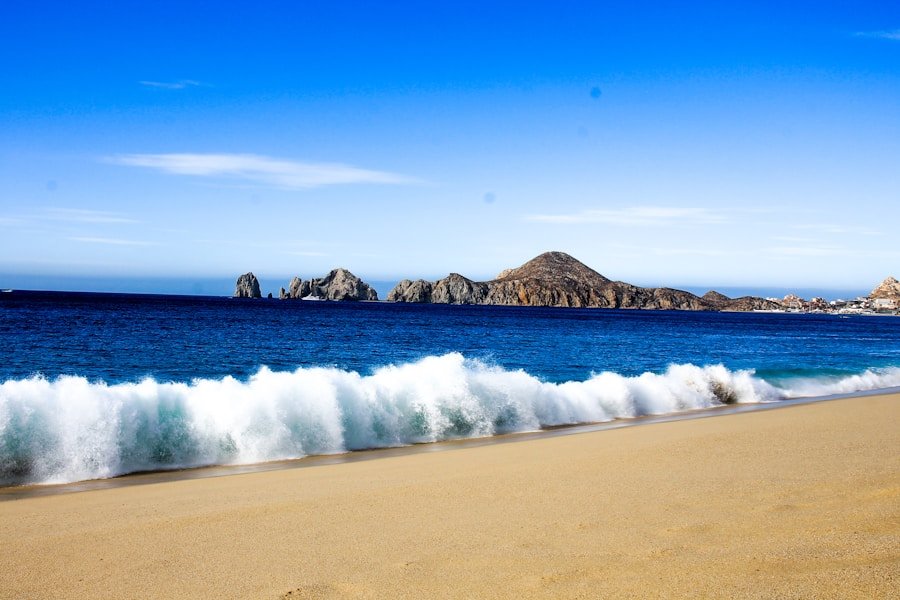When I think of Cabo San Lucas, I am often reminded of its stunning landscapes, vibrant culture, and the warm embrace of the sun. Nestled at the southern tip of the Baja California Peninsula, Cabo experiences a unique blend of seasonal changes that can significantly influence my travel plans. The seasons here are generally divided into two main categories: the dry season and the wet season.
The dry season, which spans from November to June, is characterised by clear skies and minimal rainfall, making it an ideal time for beachgoers and outdoor enthusiasts alike. Conversely, the wet season, from July to October, brings increased humidity and occasional rain showers, which can deter some visitors but also offers a different perspective on the region’s natural beauty. As I delve deeper into the seasons, I find that each one has its own charm.
The dry season is particularly appealing for those seeking sun-soaked days and balmy evenings. The temperatures during this time typically range from 20°C to 30°C, creating a perfect environment for swimming, snorkelling, and exploring the stunning coastline.
The lush greenery that emerges after the rains transforms the landscape into a vibrant tapestry of colours, and the occasional downpour can provide a refreshing break from the heat. Understanding these seasonal nuances allows me to tailor my visit to Cabo according to my preferences and interests.
Summary
- Cabo has two main seasons: the dry season from November to June and the wet season from July to October.
- The weather in Cabo is generally warm and sunny, with average temperatures ranging from 70°F to 100°F.
- The peak tourist seasons in Cabo are during the winter months and spring break, when the weather is at its best.
- Off-peak times to visit Cabo are during the summer and early autumn, when the weather is hot and humid but the crowds are thinner.
- Special events and festivals in Cabo include the Los Cabos International Film Festival in November and the San Jose del Cabo Art Walk from November to June.
Weather Patterns and Climate in Cabo
The climate in Cabo San Lucas is predominantly classified as a desert climate, which means that it experiences very little rainfall throughout the year. However, I have come to appreciate the subtle variations in weather patterns that occur across different months. The average annual temperature hovers around 25°C, but it can soar during the peak summer months of July and August, often reaching above 35°This intense heat can be quite overwhelming for those unaccustomed to such temperatures, prompting me to plan my outdoor activities for the cooler parts of the day.
During the dry season, I relish the consistent weather that Cabo offers. With an average of 300 sunny days per year, I can confidently plan beach outings and excursions without worrying about unexpected rain. However, as I transition into the wet season, I must remain mindful of the potential for tropical storms and hurricanes, particularly from August to October.
While these events are not guaranteed, they can disrupt travel plans and lead to temporary closures of certain attractions. By staying informed about weather forecasts and being flexible with my itinerary, I can navigate these challenges and still enjoy all that Cabo has to offer.
Peak Tourist Seasons in Cabo

As I consider my travel options, I cannot overlook the impact of peak tourist seasons on my experience in Cabo. The peak season typically runs from December to April when visitors flock to the region to escape colder climates in search of sun and relaxation. During this time, I find that hotels and resorts are often fully booked, and popular attractions can become crowded with tourists eager to soak up the sun.
While this bustling atmosphere can be invigorating, it also means that I need to plan ahead if I want to secure accommodations and make reservations for activities. In addition to the influx of tourists during these months, I have noticed that prices for flights and accommodations tend to rise significantly. This surge in demand can make it challenging for budget-conscious travellers like myself to find affordable options.
However, I have discovered that visiting during shoulder seasons—late April to June and late October to early November—can provide a sweet spot where I can enjoy pleasant weather while avoiding the throngs of tourists. This allows me to experience Cabo’s beauty more intimately while still enjoying many of the same activities available during peak season.
Off-Peak Times to Visit Cabo
| Month | Visitor Numbers | Temperature (°C) |
|---|---|---|
| January | 50,000 | 22 |
| February | 45,000 | 23 |
| March | 40,000 | 24 |
| April | 35,000 | 25 |
| May | 30,000 | 26 |
| June | 25,000 | 27 |
For those who prefer a quieter experience, off-peak times in Cabo present an excellent opportunity for exploration without the crowds.
However, I have found that visiting during this period can be incredibly rewarding.
The beaches are less crowded, allowing me to find my own slice of paradise where I can relax and unwind without feeling rushed or jostled by fellow sun-seekers. Moreover, travelling during off-peak times often means more affordable accommodation options and better deals on activities. I have taken advantage of this by booking excursions such as whale watching or diving trips at a fraction of the cost compared to peak season prices.
Additionally, local businesses may offer special promotions or discounts to attract visitors during quieter months. This not only enhances my travel experience but also allows me to support local enterprises that thrive on tourism.
Special Events and Festivals in Cabo
Cabo San Lucas is not just a destination for sunbathing; it is also a vibrant hub of culture and celebration. Throughout the year, various special events and festivals take place that showcase the region’s rich heritage and lively spirit. One event that stands out in my memory is the annual Cabo San Lucas International Film Festival held in November.
This festival attracts filmmakers and cinephiles from around the world, providing an opportunity for me to immerse myself in cinematic artistry while enjoying stunning coastal views. Another highlight on my calendar is Dia de los Muertos (Day of the Dead), celebrated on November 1st and 2nd. This traditional Mexican holiday is a beautiful tribute to loved ones who have passed away, featuring colourful altars adorned with flowers, candles, and photographs.
Participating in local festivities during this time allows me to connect with Cabo’s culture on a deeper level while experiencing its unique customs and traditions firsthand. These events not only enrich my travel experience but also create lasting memories that I cherish long after my visit.
Best Times for Outdoor Activities in Cabo

As an outdoor enthusiast, I am always on the lookout for the best times to engage in various activities while visiting Cabo San Lucas. The dry season is undoubtedly ideal for most outdoor pursuits such as hiking, fishing, and water sports. With temperatures ranging from mild to warm during this period, I can comfortably explore iconic landmarks like El Arco or embark on a thrilling whale-watching adventure without worrying about extreme heat or sudden rain showers.
However, I have also discovered that certain activities are best enjoyed during specific times of the year. For instance, if I am keen on sportfishing, planning my trip between June and November increases my chances of reeling in marlin or dorado during their peak seasons. Similarly, if snorkelling or diving is on my agenda, visiting between late summer and early autumn allows me to witness vibrant marine life as it thrives in warmer waters.
By aligning my outdoor activities with seasonal patterns, I can maximise my enjoyment while making unforgettable memories in Cabo’s stunning natural surroundings.
Tips for Avoiding Crowds in Cabo
Navigating through crowds can sometimes detract from my overall experience when visiting popular destinations like Cabo San Lucas. To make the most of my trip while avoiding large groups of tourists, I have developed several strategies that have proven effective over time. One of my primary tactics is to plan my visits to popular attractions during off-peak hours—early mornings or late afternoons tend to be less crowded than midday when most tourists are out exploring.
Additionally, I have found that exploring lesser-known beaches or hidden gems away from the main tourist hotspots can provide a more tranquil experience. For instance, instead of heading straight to Medano Beach, I might venture to Playa Santa Maria or Playa Chileno for a more serene atmosphere where I can relax without feeling overwhelmed by crowds. Furthermore, opting for guided tours that cater to smaller groups allows me to enjoy personalised experiences while still discovering Cabo’s beauty.
Finding Your Ideal Time to Visit Cabo
In conclusion, finding my ideal time to visit Cabo San Lucas requires careful consideration of various factors such as weather patterns, tourist seasons, special events, and personal preferences for outdoor activities. By understanding the nuances of each season and being mindful of peak tourist times, I can tailor my travel plans to create an unforgettable experience that aligns with my interests. Whether I choose to bask in the sun during peak season or explore Cabo’s hidden treasures during off-peak times, each visit offers its own unique charm and opportunities for adventure.
Ultimately, it is about striking a balance between enjoying all that this beautiful destination has to offer while ensuring that my experience remains enjoyable and memorable. With careful planning and an open mind, I am confident that every trip to Cabo will leave me with cherished memories that will last a lifetime.
When planning a trip to Cabo, it is important to consider the best time to visit in order to make the most of your experience. According to a recent article on cabo-adventures.net, the ideal time to travel to Cabo is during the winter months, from November to April, when the weather is mild and the beaches are less crowded. This is also the peak season for whale watching, making it a popular time for tourists to visit. Be sure to check out the article for more tips on planning your trip to Cabo.
FAQs
What is the best time to travel to Cabo?
The best time to travel to Cabo is during the winter months, from November to April, when the weather is dry and temperatures are comfortable.
What is the weather like in Cabo during the best time to travel?
During the best time to travel to Cabo, the weather is typically sunny and dry, with temperatures ranging from 70°F to 85°F.
Are there any specific events or festivals during the best time to travel to Cabo?
During the best time to travel to Cabo, there are several events and festivals, including the Los Cabos International Film Festival in November and the San Jose del Cabo Art Walk, which takes place every Thursday evening from November to June.
Is it more expensive to travel to Cabo during the best time?
Traveling to Cabo during the best time may be more expensive, as it is the peak tourist season. It is advisable to book accommodation and flights in advance to secure the best prices.
What activities are available in Cabo during the best time to travel?
During the best time to travel to Cabo, visitors can enjoy a variety of activities, including snorkeling, whale watching, golfing, and exploring the town’s vibrant nightlife and dining scene.



